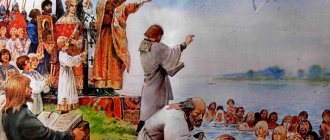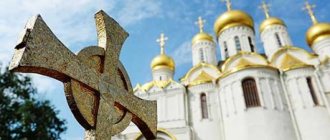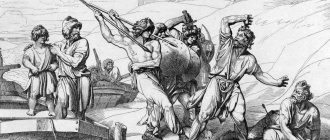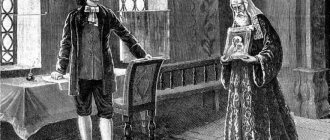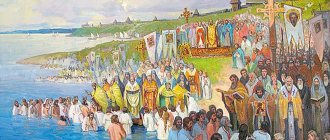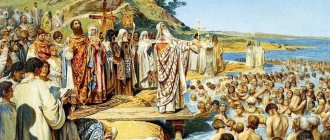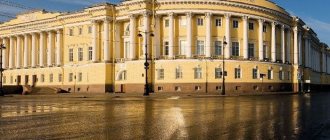- August 19, 2019
- Events
- Arina Mikhalkova
The adoption of Christianity in Rus' became an important historical event in the formation of East Slavic civilization. As a result of this step, significant changes occurred in the ethnic, socio-economic, political and cultural life of society. Recognition and affirmation of the “Greek faith” was a necessity, since it equated the young state with the rest of the firmly established powers, where the pagans were perceived as inferior peoples. The article will examine in what century Rus' adopted Christianity, identify the reasons contributing to this process, and analyze the features of the introduction of the new faith.
Before baptism
The first Russian chroniclers recording the chronicle of their native lands appeared no earlier than the 11th century. For this reason, the version of events of the 9th–10th centuries, with the exception of a few Greek manuscripts, had no other sources of origin other than oral traditions, the reliability of which is very doubtful. Therefore, due to the lack of authentic documents, the history of the time when Christianity appeared in Rus' is rather poorly studied.
The pagan beliefs of the Slavic tribes that once lived on the territory of modern Russia are little known. Mythology and religious rituals were an important component of their lives. They worshiped nature and its powers, believing that it was inhabited by creatures unlike people (ghouls, beregins, spirits of evil). Through various rituals, the Proto-Slavs celebrated the changes occurring in the environment, thereby creating a circle of certain pagan holidays. Later, a cult associated with agriculture appeared; they began to venerate Rod (the patron spirit of the clan, fate) and the goddesses of Rozhanits Lada and Lelya (patrons of fertility, pregnant women and women in labor).
During the era of the formation of state associations on the lands of the ancient Slavs, a pagan pantheon was formed, in which each deity was assigned to a separate aspect of life. There were many of them: Svarog (walker in the sky), Veles (giver of wealth and prosperity, patron of wanderers), Perun (thunderer, later patron of warriors), Dazhdbog (god of the sun), Makosh (goddess of abundance, patroness of women) and others. However, the images of the demiurges never gained any clarity and certainty among the Slavs: there were neither special sanctuaries nor a designated class of priests. Only in places, in open spaces, were crude images of idols installed, to which sacrifices (sometimes human) were made, but that was all.
In the footsteps of our ancestors
Ancient legends say that the first steps of Christianity in Rus' were taken by the holy Apostle Andrew the First-Called. Preaching the Gospel, the apostle passed through Thrace, Scythia, Sarmatia and reached the Dnieper mountains, where Kyiv was later built. He predicted that one day a glorious city and churches would rise in this place.
Traces of Christians are noted on the southwestern borders of the Russian land among the Tivertsy and Uglich tribes, who inhabited areas on the lower Dniester and up to the lower Danube. According to the records of Blessed Theodoret, it is known that John Chrysostom tried to instill Christianity among his Greek neighbors and Scythian nomads who lived near the Danube. Sources tell us that the Scythian (or Tomitan) diocese was located at its mouth, and the edifying teachings of the church fathers had the opportunity to reach the clearings located south of Kyiv. In the 4th century, the diocese was owned by the Goths, a nomadic people who lived in the southern regions between the Danube and the Dnieper. Later, when the Slavic tribes discovered Byzantium and began to travel there for trade and to serve in the imperial troops, they became more familiar with the “other” faith. Christianity began to be celebrated in flashes in Rus', but in general the Eastern Slavs were under the strong influence of paganism.
The first Christians in Rus'
The adoption of Christianity by Varangian and Slavic warriors was mentioned back in the 9th century. At first, baptism was celebrated in isolated cases, mainly by warriors who participated in campaigns against Byzantium and conducting trade with Greek Christians. Their decision to change their faith was quite understandable: they spent most of their lives on the road and in foreign lands, where they constantly contemplated the majestic cathedrals and the special solemnity of divine services, and then compared the existing cults in Rus' with Christianity. Thus, the number of Varangians who believed became larger.
There is reason to believe that in the early or mid-860s, the first Kyiv princes Askold and Dir, with a small number of people, received baptism in Kyiv, after the Russians marched on Constantinople. Some historians present these events as the first date when Christianity was adopted in Rus' (the baptism of Photius, or Askold).
Further, Russian Christians are also mentioned in the treaty with the Greeks in 944. Much credit for the arrival of the Christian faith in Russian lands belongs to Princess Olga, who was baptized during her visit to Constantinople (958). During her reign, Christianity in Rus' began to occupy a significant position, and the pagans were forced to reckon with it. Some researchers are inclined to believe that Olga’s conversion was the result of a complex political game with the Emperor of Byzantium, Constantine Porphyrogenitus.
Prince Vladimir's choice of a new state religion
As the legend says, the history of the baptism of Rus' began with the reception of representatives of the world's main religions in Kyiv. Muslims from Volga Bulgaria, Jews, Latin Rite Christians (Catholics) and Eastern Rite Christians (Orthodox) arrived. These religions were professed by Rus''s neighbors, so it was the choice of a strategic ally. A political step that changed the history of the state for centuries to come. To the Jews from Khazaria, Vladimir answered something like this: “How do you teach others if you are rejected by God and scattered across foreign lands, or do you want the same for us?”
The answer to representatives of Islam, which prohibits the consumption of alcohol, read: in Rus' there is fun - drinking, we cannot live without it. Western Christians of the ritual encountered the answer: “Go away, for even our fathers did not accept this.” Most likely, it was meant that during Olga’s time, part of the Russian nobility adopted Orthodoxy. Prince Vladimir sends his embassies to these countries to “test their service.” After returning from Byzantium, the ambassadors said that they were amazed by the beauty and grandeur of the temples. During the services, they could not understand where they were: on earth or in heaven. The ambassadors attended the Liturgy in the Church of Sophia in Constantinople.
At the crossroads
In what century was Christianity adopted in Rus'? It is known that this happened in the 10th century, but the sequence of events remains unclear. After a long internecine struggle, Vladimir (grandson of Princess Olga) ascended to the Kiev throne in 980, under whom the Russian state was able to significantly expand its borders and strengthen its southern borders. In an attempt to unite the separated lands, the prince wanted to create a single pantheon of revered gods in the capital city, but was not successful in this. After some time, Christianity was adopted in Rus' as the main state religion.
By the beginning of Vladimir’s reign, the seeds of Christian teaching had already sprouted on the territory of the state. At the same time, the prince still gave preference to the pagan gods, although he was fully aware of all the shortcomings of the faith of his ancestors. The subsequent failure of religious reform pushed him to search for a new religion that could replace paganism and thoroughly strengthen state power. The decision was also dictated by the fact that all the powers surrounding Rus' already had such religions.
According to chronicles, envoys of three monotheistic faiths came to the Kyiv ruler: Islam, Judaism and Christianity. The last of them was especially well known in Kyiv due to frequent connections with Constantinople. Gathering the boyars and elders, Vladimir held council with them in choosing a new faith for the state. On their recommendation, he sent his people to different countries to find out which faith would best suit the Russians. As a result, preference was given to the Greek faith.
Choices
Although the division of the branches of Christianity occurred only in 1054, already in those days it was possible to describe the differences between Orthodoxy and Catholicism. Both faiths had their pros and cons, which are presented in the table.
| Divergence | Orthodoxy | Catholicism |
| Rituals | Communion was carried out with bread and wine | Only the clergy could receive communion with wine, and everyone else did it in circles made of dough, which were called wafers. |
| Language | Any | Latin |
| Relations between church and state | There was a subordination of the clergy to state power | The head of the clergy and the entire political world was the Pope. |
If we list all the pros and cons of both branches, it becomes clear that Prince Vladimir had no desire to have a positive attitude towards the Catholic faith, since his plans did not include submission to the Pope.
Vladimir's baptism
The baptism of Vladimir and his immediate circle took place in 988 in the Greek city of Korsun. This event was somewhat forced by the course of complex diplomatic relations and agreements between Russia and Byzantium. The Russian prince was not satisfied with Christianity according to the Byzantine model, since in this case the Russians became directly dependent on the empire. However, the experience of the Bulgarian state, which had an independent patriarchate, inspired Vladimir to realize his own plan: to become related to the Byzantine rulers.
In 987, in order to eliminate the formidable rebel Bardas Phocas, who wanted to take the Byzantine throne, Emperor Vasily II asked for help from the Russian prince, not skimping on promises of reciprocal gratitude. According to the records of an Arab historian of the 11th century, tracking the time and events of the period when Christianity was adopted in Rus', an agreement was concluded between the two rulers, where the main condition was Vladimir’s marriage to Princess Anna, the emperor’s sister. The second important point of this agreement was the mandatory baptism of the Russian prince and his people.
Thanks to the intervention of the princely squad, the revolt among the neighbors was successfully suppressed, and its instigator Varda Foka was eliminated. Nevertheless, the Byzantine emperor was in no hurry to fulfill his promises to Vladimir. Then he decided to remind himself and captured the city of Korsun, sending the corresponding news to the Byzantine throne. The threat had to be heeded and reconciled: the Russian prince was baptized and married to Princess Anna.
Decision-making
After studying the Orthodox faith, its acceptance did not occur immediately . This was preceded by serious events. Vladimir wanted the weakening of Byzantium. To this end, his troops besieged Chersonesos and quickly captured it.
From there a message was sent to Constantinople demanding that the emperor's sister Anna be given as a wife to the prince. It was carried out because Byzantium did not want to come into conflict with Kievan Rus.
At the same time, a condition was set in response: Kievan Rus must accept Christianity. Such an offer could not be called unprofitable. Whatever Vladimir's preliminary plan, the decision was made in favor of Orthodoxy.
Introduction of a "new" faith
Kyiv, obeying the will of Vladimir, was the first to be baptized in the waters of the Dnieper. The event took place at the end of July 988, when, by a princely decree, the inhabitants of the city were gathered on the banks of the river and, through a ritual, converted to a new faith. This date became the official day of celebration of the baptism of Rus', but in fact it only marked the beginning of a long process that lasted for several centuries.
For most historians, the question of in what century Christianity was finally adopted is still controversial. In many areas, paganism had a strong position for quite some time, and periodic riots were organized before the Christian faith found its feet as a state religion. Some territories had to be baptized literally “with the sword”, due to strong resistance from the population who did not want to betray their gods. In the Vladimir-Suzdal principality in 1024, supporters of the old faith rebelled, in 1071 the rebellion in Novgorod was suppressed, Rostov came to terms with baptism only at the end of the 11th century, and the city of Murom lasted until the 12th century.
It is interesting to note that the arrival of Christianity in Rus', in its consequences and overall significance, is often compared with the transformations of Peter the Great.
Regardless of the reasons, we know the result.
Bewitched or initially malicious, Vladimir converts to Christianity and forcibly baptizes Kyiv and Novgorod. He decides to join the faith of a close trading partner. Despite the fact that the partner was not strong.
Some historians argue that the entire plan for the adoption of Christianity was dictated by Vladimir’s desire to also capture Byzantium. If not yourself, then organize the inheritance of your children.
In addition, such an alliance with Byzantium was less enslaving than other options. To accept Catholicism meant to bend to the Germans; Islam and Judaism meant having weak allies nearby.
There was also a question of money; under Catholicism, specific amounts would have to be paid to the Papal Throne, but Byzantine Christianity was both cheaper and more familiar.
In addition, part of the squad had already been baptized, and Christian communities had existed in many cities for a long time.
The adoption of Christianity also meant a kinder attitude, both from Muslims and from Jews, as well as other Christian states.
This move allowed Vladimir to avoid various rumors, because Christianity was a new religion. And starting again is easier than trying to rebuild the old one. Only we know what came of it.
The emergence of Christianity in Rus': reasons
Having chosen the Greek faith, Vladimir was guided not so much by religious inspiration as by state considerations. This fateful decision made it possible to introduce the Russian people to high standards of culture and successfully develop public life. The Baptism of Rus' marked the beginning of the formation of modern Russian civilization, and was provoked by a complex of certain factors.
Reasons for the adoption of Christianity in Rus':
- the introduction of the state into the European world;
- establishing diplomatic, trade and cultural relations with Christian states;
- the formation of a unified ancient Russian society on common spiritual and moral principles;
- strengthening Russian statehood;
- formation of urban culture;
- development of education, art and architecture, creation of artistic and aesthetic values.
Thus, Byzantium tied its strong northern neighbor to itself with religious ties, finding in it a serious ally. Kyiv, in turn, received a religious and ideological means to strengthen statehood in the emerging feudal order.
bogemasamara.ru
The very cultural and historical choice of Eastern Christianity as the state religion by ancient Russian society was dictated not only by the state-political wisdom of Prince Vladimir and those layers of early feudal society among the Eastern Slavs, which he represented in his politics, but also by the potential “predisposition” of the ancient East Slavic culture specifically to this and not another choice.
The chronicle does not contain a convincing motivation for this particular decision. Obviously, in the depths of the cultural and historical choice made by Russia there are several different, although closely related, reasons for making the decision that was necessary for Rus' at that stage.
Reason #1; In the foreground of motivation was the territorial proximity of Byzantium as a cultural, religious and political center, which had long been felt by Russia as an important factor in historical development. There is no doubt that in all respects Constantinople as a cultural-political and spiritual-religious center was closer to Rus' than Jerusalem or Rome. The events that took place in Byzantium were more reliable and understandable to the top of ancient Russian society than those that took place among the Romans or Arabs.
Reason No. 2; The Byzantine Empire was not only a rich and powerful neighbor for the Russians, but also, in a certain sense, acted as an ideal of state power, worldwide recognition, economic and spiritual wealth, as an example, model, standard of an optimal social structure - centralized, hierarchical, regulated to the smallest detail ritual or ceremonial in nature. Baptism could be recognized in this sense as an act of cultural and historical “leveling.”
Reason No. 3; It is not entirely clear from the chronicle narrative what the motives for Prince Vladimir’s refusal of Christianity in its Western version (future Catholicism) were. Judging by the text of The Tale of Bygone Years, the Pope's envoys diligently proved the minimality of their ritual prohibitions. Vladimir, according to legend, without asking unnecessary questions, sent the papal messengers back. It can be assumed that the choice of Eastern Christianity was based on the religious and cultural experience of our ancestors and was indeed sanctified by the covenants of our fathers. The veneration of ancestors, centuries-old customs, and value systems rooted in everyday life and way of life was characteristic of the Eastern Slavs. In this regard, the Old Russian people, which were just taking shape in the 10th century, were ethnoculturally close to the eastern peoples with their emphasis on preferential traditionalism. Therefore, a radical change in the entire system of values and cultural norms had to be based - at least conditionally and partially - on tradition, on existing sociocultural experience.
Reason No. 4; The preference for the eastern branch of Christianity was also associated with cultural and political factors. The adoption of the Western branch of Christianity meant for Rus' the recognition of the power of the pope over itself. Such religious-spiritual or state-political dependence did not suit the ancient Russian princes with their natural desire for state independence and independence, for cultural and religious self-affirmation and did not correspond to the historical tasks that the ancient Russian people, striving for cultural, political and religious-spiritual design.
Thus, in the person of Byzantium and the Eastern Christian Church, ancient Rus' received an ideal model for overcoming paganism in the forms of Christianity, moreover, in cultural and historical conditions as close as possible to those of ancient Russia.
The adoption of Christianity in Rus' in the Orthodox tradition is a natural and objective process associated with the development of feudal relations, familiarization with European civilization, the formation and development of national Russian culture through Byzantine and ancient culture.
At the head of the church was the Kiev Metropolitan, who was appointed from Constantinople or by the Kyiv prince himself, followed by the election of bishops by a council. In the large cities of Rus', bishops were in charge of all practical affairs of the church. The metropolitan and bishops owned lands, villages, and cities. The princes gave almost a tenth of the funds collected to the treasury for the maintenance of churches. In addition, the church had its own court and legislation, which gave the right to intervene in almost all aspects of the life of parishioners.
Christianity played a large role in the ideological justification and thereby in strengthening the power of the Kyiv princes. The Church assigns to the Kyiv prince all the attributes of Christian emperors. On many coins minted according to Greek designs, princes are depicted in Byzantine imperial attire.
The transition to Christianity was objectively of great and progressive significance. The unity of the Slavs strengthened, the withering away of the remnants of marriage law accelerated.
The exact date of birth of the prince could not be reliably established, but historians date this period to 962. The future ruler grew up and was brought up under the supervision of his grandmother, Princess Olga. And by the age of 17, he accepted the lands donated by his father into independent rule. According to legend, Vladimir was a competent commander and enjoyed authority among his squad. Along with all his virtues, he is credited with debauchery and cruelty. In some chronicles that have survived to this day, he led a depraved lifestyle from a young age. In addition to several official wives, which was allowed in paganism, he had at his disposal several hundred concubines with whom he indulged in lovemaking while on military campaigns. He treated one of his wives with particular cruelty. Rogneda at that time was declared the bride of his brother, Yaropolk. Wooing her, he was refused, after which he gathered an army and won a victory over Polotsk, taking Rogneda as his wife without her consent. She was dishonored by Vladimir right in front of her parents, after which they were brutally killed. The prince strove for power in every possible way and often caused the death of innocent people.
As for faith, Vladimir was a devoted pagan and sacredly revered the canons of this religion. What prompted the prince to such serious ideological changes still causes debate among historians. Some argue that this act was committed only for mercantile reasons. Although this version is in no way consistent with the events taking place at that time. In general, order reigned in the prince’s possessions, including regarding political structures. Therefore, the official version interprets another reason - Vladimir often thought about the hopelessness of human existence and tried to search for the truth. The chronicles also describe an incident that forced the prince to reconsider the principles of paganism. Returning from another campaign, Vladimir decided to thank the pagan gods and make a sacrifice to them. A young guy, John, was chosen as the victim. The young man's father did his best to prevent the sacrifice, publicly condemning pagan idols. As a result, father and son were killed by the prince's squad. These events prompted Vladimir to think seriously. He began to think about changing the ideological heritage and internal regulations of his state. The prince walked towards the adoption of Christianity for quite a long time, deeply studying the canons of different faiths. He even communicated with representatives of different religions in order to find what was closer to the people and himself. After a long study of the laws of Orthodoxy, he made a decision that subsequently changed the religion of an entire people.
NEW WAY
So, Vladimir stained himself with the murder of Rogvolod and his sons, who
were not guilty of anything and did not even fight with him. He raped his daughter
Rogvoloda Rogned. She even wanted to kill Vladimir, avenging the death of her father and
brothers. Vladimir treacherously killed his own brother. He betrayed his own
comrades in arms - the Varangians. This prince, and the chronicle is evidence of this,
there were enough sins. A heavy burden fell on his reputation as a warrior
Korsun adventure. So, the bright memory of him, preserved
descendants to this day, can it be called undeserved?
No! Historical memory connects the image of Vladimir not with his personal
qualities and political successes, and with a more significant act -
the choice of faith that inspired the life of the people. In fact, having spread its
power over almost all Slavic-Russian lands, Vladimir inevitably must
was to adhere to some kind of, as they would say today, “nationwide”
political program, which, according to the conditions of that time, was expressed in
religious form.
To religions (theistic worldview systems) that had a significant
influence on the situation in Eastern Europe in the 10th century should include:
Orthodoxy, Catholicism and Islam. Russian "seekers of faith" were supposed to
imagine and were fully aware of the differences between these major religions.
The latter is not surprising: Kyiv merchants and warriors constantly visited
Constantinople, fought in Crete and Asia Minor, traded with the Egyptians
and Syrians, traveled to Volga Bulgaria and Khorezm. Acceptance of a certain
faith automatically led to an orientation toward very specific
groups within the country. Therefore, the “choice” facing Prince Vladimir
faith” cannot be called easy. But this problem also had an international
aspect due to constant super-ethnic contacts.
In the time preceding the baptism of Rus', menacing signs grew
the coming schism in the hitherto united Christian world. And here at the core
ideological disputes also lay behind natural, objective processes
ethnogenesis. Western European culture, which was in a phase of passionary rise,
super-ethnic integrity felt its difference from other super-ethnic groups
very sharply and clothed him in the vestments of church superiority, calling
“Christian world” only itself. The struggle between Orthodoxy and Catholicism
began to move from the sphere of theological disagreements to the field of politics.
The German Emperor Otto II at the Imperial Diet of 983 in Verona achieved
decisions on war against the “Greeks and Saracens.” This equalization of the Orthodox
Christians and Muslims were no longer allowed to talk about the unity of the Church of Christ,
made the threat of a Catholic onslaught on the East quite real, including
and to Rus'. In Rus' this was understood too well, since even before the Verona
Sejm, the Polish Catholic king Mieszko 1 fought with the Kyiv prince over
Chervlenaya Rus (Galicia), and the already mentioned Otto II - with Western
Slavs on the Elbe (Lab) River.
The very circumstances of Vladimir’s “choice of faith” are widely known and are set out in
"Tales of Bygone Years." According to Nestor's version, the prince, wishing
understand different confessions, sent his envoys to neighboring lands and
then he received representatives of all the teachings of that time. How real are these
details are not so important to us, because what is much more important is
Vladimir’s motivation for his decision to be baptized in Greek
Speaking about motives, let us take into account that, in addition to dogmas, in any religion there are
customs traditionally passed down from generation to generation. Such customs for
converts sometimes mean more than holy books, especially if these
books are written in an unknown language. Thus, the main book of Islam - the Koran -
written in Arabic, incomprehensible to the Slavs. Muslim customs, for example
not drinking wine, not eating pork, simple, but for the Slavs they were unacceptable. AND
that's why. According to Russian custom, the prince shared a meal with his retinue. This
an obligatory ritual cemented the friendship of the prince with the soldiers, and what could have happened for
is the prince more important? Less significant, but quite significant, was one more
circumstance. The Slavs and Rus were accustomed to intoxicating drinks, since wine and
beer relieved the fatigue of hiking, but the strict ritual of feasts did not allow
"Rampages in hops." Of course, the Arabs, having converted to Islam, did not stop drinking wine,
but they did it in a narrow circle of relatives and friends, appearing in public places
sober. They did not have feast rituals and corresponding stereotypes
behavior. As a result, Vladimir refused the famous Muslim mullahs
words: “Rus' has joy to drink...”
The reasons for Vladimir’s refusal to the Catholic Germans are more complex. His words are unclear:
“Go where you came from, for our fathers did not accept this.” Let's try
to figure out what exactly “the fathers did not accept.” In the middle of the 10th century. arrived in Rus'
Bishop Adalbert on the mission of baptizing Princess Olga and the people of Kiev. Adalbert
failed, but “not through negligence.”
It is known that in the middle of the century very
sinful dads. In 955, a sixteen-year-old youth sat on the papal throne,
named Pope John XII. The Vatican court has become a den of corruption
women. If dad were only a hunter, a gambler, a red tape worker and a drunkard,
then that wouldn't be so bad. But the Roman high priest gave feasts with
libations in honor of the ancient pagan gods and drank to the health of Satan.
Of course, news of such “exploits” reached Rus'. Chronological
coincidence of atrocities in Rome and the expulsion of Adalbert from Kyiv by chance
it can not be. Therefore, the tradition of rejecting the Latin faith and conscious
the choice of Greek actually goes back to Vladimir's ancestors as a prince
table: Princess Olga and her grandson Yaropolk.
But the story about the Khazar Jews coming to Vladimir is an example of an obvious
literary creativity of Nestor. The Jews allegedly confess to Vladimir:
“Our land was given over to the Christians.” In fact, in the 10th century. Palestine was
in the hands of Muslims. The chronicler shifted the dates. It is noteworthy that, according to the chronicle,
Vladimir did not address the Jews, but only received them in order to drive them away.
Consequently, Nestor's chronicle records the last attempt of the Khazar
Jews to take over the hands of the Kyiv prince, done when the Khazar
the kaganate no longer existed. The outcome of the attempt is known: Vladimir was
insightful.
The military and political consequences of choosing faith were very great. Made
the choice not only gave Vladimir a strong ally - Byzantium, but also reconciled
him with the population of his own capital. Some resistance to baptism
At first, Novgorod and Chernigov showed a preference for paganism. But
the pagans of Novgorod were broken by military force, and after some time
Chernigov, together with Smolensk, also adopted Christianity. Now before
The Kyiv prince was left with only foreign policy problems.
The Pechenegs reigned in the steppes between Russia and the Black Sea. It is the Pechenegs,
rich from trade with Korsun and Byzantium, opposed the prince
Vladimir. We only know the result of the collision, which,
presumably resulted in quite a war; Vladimir had to fence
palisade their lands, place “guards”, and also renounce hegemony
in the southern Russian steppes and from the exit to the Black Sea.
The enemies of the Russians and Byzantium were the Pechenegs in the 10th century. were pagans. In the 11th century This
the tribe converted to Islam. Conversion to Mohammedanism was accompanied by internecine
war. Some of the nomads were baptized, but the majority, having converted to Islam,
began to be at enmity with the Greeks. Conversion to Islam, wars with Byzantium and internal
Troubles fettered the forces of the nomads and by the end of the first third of the 11th century. saved Rus' from
Pecheneg threat.
What happened in Rus'? We see how the Orthodox Church is gradually
spread her beneficial influence, built temples and monasteries, taught
people of literacy and painting. Only in Rostov (in Meryanskaya land) for a long time
Two urban communities remained: Christian and pagan. At one end
city there was an Orthodox church, in another there was a temple of the god of the Merians
Keremet. At the same time, Christians and pagans coexisted quite peacefully, and
after the Merians killed two particularly annoying missionaries, they and
completely left alone.
So, Vladimir followed the path that was outlined by the “wisest of people” princess
Olga, who chose Orthodoxy. Having set foot on this path, throwing off the oppression of the merchant
capital of the Rakhdonites, Rus' came to baptism 988 The power of preaching
Orthodoxy was both in the political moderation of the Byzantine Empire, and in
sincerity of the Patriarchs of Constantinople, and in the charm of the Greek
liturgy (church service).
Byzantium wanted friendship from Rus' and an end to senseless raids on
Black Sea coast. Greek theologians did not spice up their sermons
Orthodoxy with crafty political intricacies. It also turned out to be important
that Orthodoxy did not preach the idea of predestination. And that's why
responsibility for sins committed of one's own free will fell on
sinner. This was understandable and acceptable to the pagans. Acceptance of Christian
moral standards were not psychological violence for converts who
accustomed to the elementary opposition of good and evil.
The goodness and wisdom of Christianity in 988 fought with Perun and the desire for
for profit - the real god of the Rakhdonites. Baptism gave our ancestors
the highest freedom - the freedom to choose between Good and Evil, and the victory of Orthodoxy
gave Rus' a thousand-year history.
Paganism is a religion or complex of religions that are not Christian. However, they had nothing to do with Islam or Judaism. The term was simply coined by Christians. Typically, paganism refers to any polytheistic religion. The name “paganism” itself appeared much later. And the belief itself arose before the new era. Then man had no knowledge other than what he could observe in nature. All occurring phenomena were explained by divine forces. It is difficult to remember which peoples were not pagans. Almost the entire population living at that time went through this stage of development of beliefs and religious views. And only a few centuries after the beginning of the new era, paganism was replaced by modern world religions.
The question remains controversial and interesting whether paganism is a religion. Here opinions are divided. Some consider paganism to be a combination of many polytheistic religions. Some say this is the world's first religion. For others, paganism includes not only the concept of religion, but also other aspects of human life. This point of view is closer to us. But for simplicity, we will say that paganism is a religion.
Paganism, having common features and basic concepts, differed among different peoples. That’s why we talk about Slavic paganism, Roman paganism, Scandinavian paganism and others. What did they have in common?
Paganism is the ancient religion of the Slavs. However, religion is too narrow a concept, as has already been said. After all, paganism for our ancestors was a whole worldview system, a unique culture with its own characteristics. The religion of Slavic paganism appeared and achieved its development and independence at the dawn of the first millennium of the new era. Before this, there was a common religion for all Indo-European tribes.
Slavic religion (paganism) was a combination of the following main features:
Like all pagan religions, Slavic paganism was polytheistic. For whom the terms polytheism and paganism are the same thing, synonyms. However, this is not quite true. Paganism is a larger, more comprehensive concept. This is not only belief in many gods.
But let's return to Slavic polytheism. Each of the “participants” of the pagan pantheon was responsible for one or another natural phenomenon or aspect of human life. For example, Perun is the god of thunder, Lada is the goddess of love, and so on. Each god was represented in a certain image, with his characteristic appearance and attributes.
Why did the pagans need gods? They, in fact, were peculiar representatives of nature, higher powers. Gods were not worshiped, gods were glorified. The Slavs did not ask them for forgiveness. They were asked for a good harvest, health, success in war, in love. Moreover, you had to ask the corresponding deity. For the most revered and important, pagan temples were built - temples, sanctuaries. Some kind of worship services were held there. But the mediators between gods and people were magicians and priests. They had extraordinary wisdom. Also, sacrifices or demands were made to the gods. Do not think that the victims were human and bloody. Not at all. They brought food, grain, and flowers as gifts to the gods. Holidays were held in honor of the gods.
The Slavs had a unique idea of the existing world. The god Rod was considered the One Creator. It was he who created the three worlds. Rule - the Higher world, the divine, the world of wisdom and laws. Nav is the world of the past, the world of fundamentals. Reality is the world in which people live, real, real, visible. They all pursue the goal of procreation and constant improvement.
The disappearance of paganism
At the very beginning of the new era, when global land development was taking place, all the tribes of modern Europe and Asia were pagan. However, some time later (around the eighth century), paganism began to be gradually supplanted. The peoples adhered to Christianity, Islam, and Judaism.
Why was paganism supplanted by world religions? There were several reasons for this:
- It was becoming too primitive for developing peoples. People began to understand many natural phenomena. That is, now it was impossible to explain the existence of the simplest natural phenomena by saying that “God got angry” or “the spirits wanted it.” After all, the real physical substrates of all occurring phenomena became known and understood.
- Tribes began to form states. And in any state there is always some kind of social stratification. For paganism, all people were equal before nature. This is how contradictions arose between reality and religion.
- Paganism as a religion was not suitable for state power. It did not submit to a single ruler, a monarch.
- A monotheistic religion was needed. And the world ones were just like that.
That is why the choice was made between paganism and world religions in favor of the latter. Christianity, of course, became the most widespread. Of course, the transition from paganism to other religions took quite a long time, sometimes very difficult. Particularly interesting is the phenomenon of dual faith that existed at the beginning of the second millennium in Kievan Rus.
However, we cannot say that paganism has completely disappeared from our lives. This is not true at all. Not many people know that even after the strengthening of the Christian religion in Rus', pagan traditions, customs, and signs continue to exist today. Therefore, it is sometimes said that the world religions that replaced the pagan ones were forced to partially unite with them.
We recommend reading
- White Kremlin. History of the issue. The Kremlin will be repainted white Who built the brick Kremlin
- We study the names of stars and constellations alphabetically
- The most beautiful night sky objects to see
- What will a person look like in a thousand years?
Synthesis of paganism and Christianity
The Old Russian chronicler (“The Tale of Bygone Years”) reports in his writings that the Russians only formally became Christians, in reality they lived like “filthy ones.” Dual faith reigned in full swing in the state. The worship of Jesus was clearly similar to the worship of Perun, the Mother of God replaced the goddesses Rozhanits in the role of the female fertility deity, the sun deity Khors was traced behind St. George the Victorious, and so on. The Church, adapting to existing realities, began to connect the holidays of pagan gods with the cults of Christian saints: the day of Kupala became the day of John the Baptist, the holiday of Perun was replaced by the day of Elijah the Prophet, the pagan harvest festival overlapped with the celebration of the Dormition of the Virgin Mary. A purely pagan holiday in nature, Maslenitsa, has also been preserved. As a result, the resulting synthesis led to the formation of a distinctive religion - Russian Orthodoxy.
Christianity in Rus', as it was in the 11th-12th centuries, is clearly visible in funeral rites. In the burials, archaeologists find the corresponding symbols of faith (crosses and icons), but along with this, the deceased was also given food that was considered necessary in the afterlife. It is also worth mentioning that traditional memorial dinners after funerals, wakes for the deceased and memorial parents' day are nothing more than echoes of pagan beliefs about the soul and the afterlife.
Thus, the worldview of ancient Russian society continued to define paganism until the 15th century.
Consequences of the Christianization of Rus'
When the Russians adopted Christianity, this was reflected not only in the nature of worship services and sermons, but also in the set of accepted norms and new institutions. In 1037, the “barbarian” state received its first metropolitan, Theopompus, and the son of Prince Vladimir, Yaroslav the Wise, began the construction of the metropolis. Local church administration began to be carried out through the bishopric, subordinate to the metropolitan, whose authority now oversaw the entire clergy of Rus'. The churches received ownership of the lands on which they farmed, following Byzantine customs and laws, under which legal relations with farmers were established, as in Greece.
In a short time, the Russian church began to represent a powerful mechanism in the spiritual and social life of the state. Under her constant supervision, schools were erected everywhere, in which the clergy themselves acted as teachers. The monastery walls represented the focus of cultural and educational centers, where the works of chroniclers, translators, philosophers were born and the first national books were written. Using the example of their Greek colleagues, the clergy governed and judged people based on the collection of laws of the Nomocanon, which acquired the name The Pilot's Book. The crimes committed and the immorality of the flock replenished the church treasury with good income. In addition to the main tithe from the population, donations from high-born parishioners could be expressed in gold and silver, lands and lands, villages and cities.
It is worth adding that, despite the Byzantine influence, Kievan Rus continued to preserve the originality of its culture.
